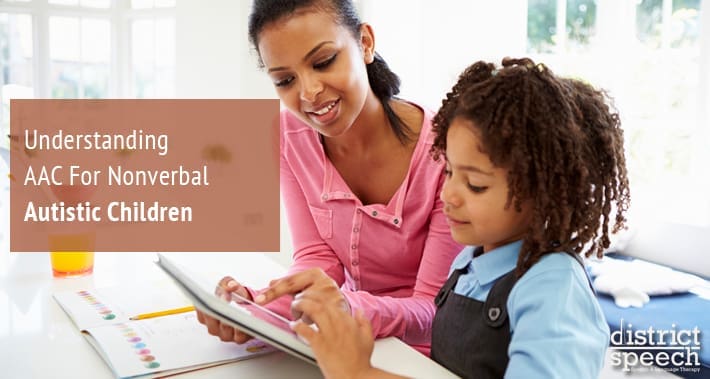
When you think of communication, what comes to mind first?
Probably speech, which is something many of us take for granted.
Although speech is how most people communicate with those around them, for some children with autism spectrum disorder, speech doesn’t come as easily.
As a speech-language pathologists in Washington that specialize in speech therapy for kids with nonverbal autism, we recognize that every child should be able to communicate with their guardians and caregivers.
As a result, we’re going to take a closer look at alternative and augmentative communication (AAC).
Keep reading to learn more.
Will AAC Hold My Child Back From Learning To Speak?
As a parent or caregiver, you may be wondering if using alternative and augmentative communication methods could deter your child from learning to speak.
This worry makes sense, as some may see AAC methods as an “out”, where a child could come to rely on them, instead of beginning to speak.
These worries are largely unfounded, however, as oftentimes children using AAC methods actually learn to speak at higher rates than children who don’t use AAC.
Although there is no guarantee that using AAC will result in an autistic child being able to speak, the use of these devices doesn’t seem to hinder their speech production either.
In short, AAC is a useful tool when approaching speech therapy for autistic children.
How Can I Tell If My Child Is Ready For AAC?
To put it briefly: there is no skill or prerequisite required in order to introduce a child to AAC devices.
Some people may assume that in order for a child to use AAC, they need to have some level of skills to use augmentative communication devices.
However, the reality is that when given the opportunity to communicate, most children will quickly pick up on the skills required to do so.
In fact, since early intervention speech therapy tends to have better results than waiting, it may be ideal to introduce your child to AAC earlier on.
What AAC Options Are Best For Nonverbal Autistic Children?
There are a variety of different methods of AAC which can be used for children with autism.
Some are free or very low cost, while more sophisticated programs can be purchased.
Some free options include:
- Visual aids and visual boards
- Sign language
- Picture cards
While options which can be purchased might include:
- Low and high tech communication devices
- Picture exchange communication systems
- Applications for tablets and smart phones

How To Teach Your Nonverbal Autistic Child To Use AAC
If you’ve made the decision to introduce an alternative or augmentative communication device to your autistic child, you will need to introduce it to them and show them how to use it.
Let’s review some simple steps for how to do this.
1. Demonstrate How To Use It
The best way to show your child how to an AAC is to model it for them.
Choose one word to focus on, and then hide the others.
Electronic communication devices should have an option available to only display one word at a time, or if using picture cards then only focus on one at a time.
Now model the device, by saying the word and selecting the card or image on the screen.
If your AAC method of choice is sign language, then demonstrate the sign while saying the word.
2. Give Them A Chance To Try
Once you’ve demonstrated how to use the AAC device, allow your child a chance to use it.
This could mean laying out picture cards to see if they point to anything, handing them the device to explore, or leaving it somewhere that they can pick it up and use it on their own.
3. Take A Direct Helping Role
Once they have some familiarity with the device, you can intervene and show them how to use it for communication.
This could mean moving their hands to make a sign language sign or helping guide them to select a picture card or point to something on a visual board.
As you do this, repeat the word to them at the same time.
Some children may resist being guided in this way – if you find this to be the case, limit the amount you are doing it, and only gradually increase this guidance as they tolerate it better.
4. Slowly Decrease The Help You Offer
Once you’ve been guiding your child on using the AAC for a period of time, start to reduce the amount of help and direct intervention you’re offering them.
Give them a chance to use the device on their own, and offer cues and coaching but don’t intervene directly.
Gradually reduce your usage of cues, so that they can learn to use the AAC independently.
5. Teach Them New Words
Once your child has a strong grasp on how to use the AAC, then you can go back to step one, and use it to introduce new words to them, by showing them the word repeatedly.
Book Your Appointment With District Speech Today
Are you worried that your child isn’t starting to speak even though their peers of the same age have started doing so?
Have they shown other signs of autism spectrum disorder, such as not making eye contact, repetitive movements, or not responding to their name?
Is an inability to communicate with your child resulting in meltdowns?
You don’t have to go through this alone.
We’re District Speech, and we offer pediatric speech therapy services for children and families in the Washington DC and Arlington Virginia areas, including assessments and treatments for communication delays related to autism spectrum disorder.
Make an appointment today so you can enjoy better communication with your nonverbal child tomorrow.
1300 I St NW, Suite 400 E,
Washington, DC 20005
- https://g.page/districtspeech
District Speech and Language Therapy specializes in speech therapy, physical therapy, and occupational therapy solutions, for both children and adults, in the Washington D.C and the Arlington Virginia areas.